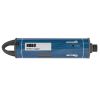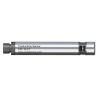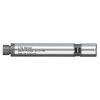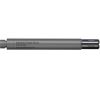HOBO MX800 2-Sensor Adapter
Features
- Turns MX800 logger into multi-parameter sensor instrument
- Can connect sensors directly (MX801), or cables to sensors (MX802)
- Protective housing screws on and off for easy access to sensors
- Free ground shipping
- Expedited repair and warranty service
- Lifetime technical support
- More
This adapter supports the connection of any two sensors to one MX800 data logger- Dissolved Oxygen (W-DO), Conductivity Sensor (W-CT), and CTD sensor (W-CTD-xx).
Sensors can be attached directly to the fully submersible MX801 model, or to the end of a W-series cable that's connected to the direct-read MX802 model. Two sensors of the same type can be attached to monitor at multiple depths. When using a DO with CT or CTD combination, salinity-adjusted DO readings are logged directly without a need to perform post-processing.
The 2-sensor adapter comes with a sensor guard that screws onto the adapter to prevent damage to sensors while allowing ample water flow. Users also have an option to purchase an additional anti-biofouling guard (W-GUARD-2), which extends time between sensor cleanings by reducing fouling of the sensor.
Full Length: 12.3"
Full Length with Anti-Fouling Guard: 12.5"
Diameter: 2.385"
Diameter with Anti-Fouling Guard: 2.5"
- 2-Sensor Adapter
- 2 sets of couplers for attaching the two sensors
- Sensor bracket for holding sensors together
- Sensor guard
- Set screws to lock sensor guard into adapter
- Tapered coupler for attaching adapter to a W-Series direct read cable
In The News
Wildfire Prevention in the Sierra Nevada Region with the Yuba Watershed Institute
Though recent wildfires have sparked new conversations about wildfire management and response, groups like the Yuba Watershed Institute have been monitoring the forests and water resources of the Sierra Nevada region for decades, managing approximately 5,000 acres of land with the Bureau of Land Management (BLM) and about 7,000 acres in private land partnerships. The goal of the Institute is to work with local communities and land agencies to improve watershed and forestry management through informed practices and public outreach. The goals of the Yuba Watershed Institute are three-fold: Improve the ability of fire suppression agencies like the California Department of Forestry and Fire Protection ( CAL FIRE ) and the US Forest Service.
Read MoreWave Sensors Integration with NexSens Buoys: A Cutting-Edge Solution for Wave Measurment
Real-time wave data supports accurate weather prediction, safe and efficient maritime operations, and provides valuable safety and operating condition information for recreation and commercial fishing. Understanding wave dynamics also helps with the design of protective coastal structures like seawalls, breakwaters, and jetties. It also supports better prediction of their impact on sediment transport and coastal geomorphology. Wave data is a key factor in qualifying and designing offshore wind farms and harnessing kinetic energy for electrical generation. It helps with the understanding of ocean-atmosphere interactions and contributes to studies of sea-level rise and climate change impacts.
Read MoreSpring 2025 Environmental Monitor Available Now
In the Spring 2025 edition of the Environmental Monitor, we highlight partnerships across the world and the importance of collaboration between government agencies, universities, environmental groups, local communities, and other stakeholders. From great white shark research in Cape Cod to monitoring fisheries in Lake Erie, this latest edition underscores partnerships that connect stakeholders in a watershed through environmental data. With an emphasis on data sharing, a combination of real-time and discrete sampling keeps the public and partners informed of environmental conditions. Our writers also sought out science professionals dedicated to working with peers within and outside of the environmental sector.
Read More











